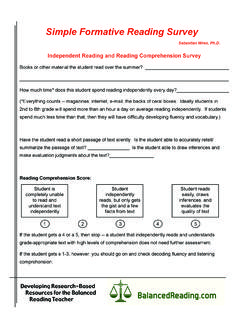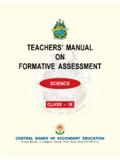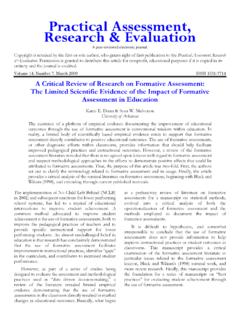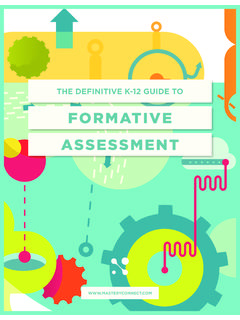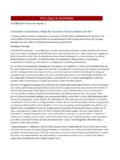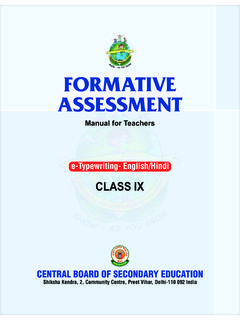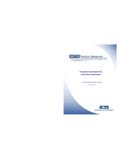Transcription of formative assessment. 54 different examples of
1 54 different examples of formative formative assessment or assignment is a tool teachers use to give feedback to students and/or guide their instruction. It is not included in a student grade, nor should it be used to judge a teacher's performance. Both of these would be considered summative presentation is licensed under a Creative Commons Share-alike, Attribution, Noncommercial may copy it, use it, share it, modify it, with attribution for non-commercial SummarizationTo check understanding, ask kids to write three different summaries:One in 10-15 wordsOne in 30-50 wordsOne in 75-100 words. The different lengths require different attention to details.
2 Compare/ contrast with peers/ look at teacher model (via document camera.)Postcard Have students write a postcard as a historical figure to another historical figure discussing and describing a historical event. 3 ThingsList 3 things that a fellow student might misunderstand about the DiagramHave students compare and contrast a topic using a Venn in, pass outAsk students questions, have them respond on notebook paper anonymously. Students then hand their papers in. Teacher immediately, randomly gives them back to students for grading. Students get practice grading others work, but shouldn't know who is who. Teacher then takes informal poll about how many questions students answered (Be the Illustrator) Read a page of the story not allowing students to see the illustration.
3 Have each student create a visualization (illustration) for that page. QuizzesGive students quizzes, which either you mark, or they mark. You can use the information gathered from the quizzes to guide your instruction, or to give feedback to the it downHave students write down an explanation of what they understand. Read these explanations to help inform your instruction, and write comments on them (or discuss them with the student) to give them Favorite NoAssign students a warm up problem or two. Hand out index cards to the students. Sort the index cards into yes/no piles. Choose your favourite no response and analyze it as a Each student, or groups of students, has a mini-whiteboard.
4 As they work through problems, they can share them either with you as a class, or you can walk around the classroom and see their somethingThis is similar to checking for transfer. Have students build/create something that requires that they apply what they have for transferCheck to make sure your students are able to transfer a concept from one domain to another. This could take a variety of forms. For example, can they identify the climax in a short story, a novel, a movie, and an advertisement?Extension ProjectsExtension projects such as: diorama poster fancy file folder collage abc booksAny creative ideas students can come up with to demonstrate additional understanding of a ItHave students draw what they understand, instead of writing Splash Numerous students respond to a prompt/question on the chalkboard or whiteboard at the same time.
5 Text RenderingStudents read an informative text independently, highlighting or writing down a few sentences they find important, interesting, of note, or that give them an Ah ha! moment. Then, group students and have each share a sentence from the text. Next, have each student pick and share a phrase from the sentence they shared. Finally, each student will pick one word from that sentence and share. Have students then discuss if the words, phrases, and sentences they chose sum up the main idea of the allows for the students to process what they did in class and why it was done. At the end of class (or each assignment if on block sched), have students complete a table similar to the one below.
6 Collect and provide did we doWhy did we do it?What did I learn?today? How can I apply it? What questions do I still have about it?Exit slipYou hand out a short quiz or a few simple questions, and students give them to you as they leave your : nodYou ask students if they understand, and they nod yes or no. - is a virtual quick nodWatch body language If you pay careful attention to the body language of your students, quite often they will communicate understanding or a lack of understanding through their body recordsAssess students on reading, keeping track of what they do as they read, and what mistakes they make (possibly including self-corrections).
7 Here is more detail on running up, middle, or downAsk the class if they understand a concept. If they (think) they get it, thumbs up. If they are not sure, thumbs middle, if they don't get it, thumbs ancient Greece they used a closed fist (I have a good grip on the matter) or an open hand. @BraddoSee ThermometerUse for Peer FeedbackStudents share with the class one thing that is being worked on such as strong leads. After the student has shared, the class raises their hands to level that they feel the item has met the criteria - no verbal comments necessary as student who shared has a very quick visual of where they are at - all the way up is "hot" or excellent - half way up is "mild" or okay, meets but could be better - just above desk height is "cold" or needs to be improvedTwo Roses and a Thorn:Name two things that you liked about a chapter, lesson, etc and one thing you did not like or you still have a question about.
8 This can be used as a wrap up or an exit up! Similar to thumbs up/down/middle - choose option or match using 1, 2, 3, 4, or 5 fingers held up with 1 meaning "I need a lot of help" and 5 meaning "I really get this."Red / green card Students hold an index card (that has a red circle on one side and a green circle on the other) in front of them where you can see it. As they are following along with you and understanding, they show the green circle side. When they miss some information, need clarification, or don't understand, they turn it to show you the red circle. Much more effective than having them raise their hands and lets you know shortly after they are lost instead of at the end of Lights Used for pre- assessment , student self- assessment and even as an exit slip.
9 Green = I know this; Yellow = I may know this OR I partially know this; Red = I don't know this. You can do this before a topic, during the topic and right after the topic. You can track their progress (and so can they). You can use coloured highlighters for this. Some also use coloured cups on a students desk as well. You can also laminate strips of construction paper, one of each color (r,y,g), single-hole punch on short end, and place on a ring. Students can then raise the appropriate color at any point during the class. (@brandonhebert)Google Forms"Comments/questions/suggestions about the lesson?" Students who normally would not participate in class will participate each student a student response system (or clicker) or use a service like Socrative teacher, Poll Anywhere, or Google Docs and ask questions during class, and have students respond individually (or in groups) to the the Flubaroo script to create self-marking quizzes that students can take for formative feedback on their students questions during class.
10 Use a procedure for asking questions which ensures that all students have a chance to be asked a question, and include students who might not otherwise participate. Apps such as TeacherPal (free) can be used to randomly call on students without repetition or leaving anyone out, for those of us who can't touch popsicle the answerStudents text their answer to a site such as Wifitti ( ). It hides their actual identity so they can be honest and not feel Google DocsHave students do their writing in Google Docs. Either you observe their writing, or a peer does, and gives live feedback while they are writing. Feedback should not be "oops you made a mistake" but "oh that's interesting, what made you add that?
